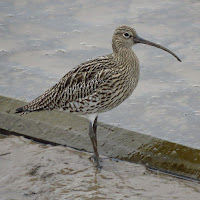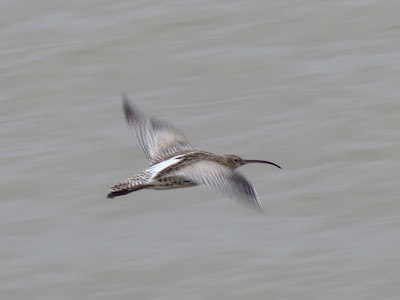 A large wader with a long, down-curved bill, the curlew is unmistakable. They are brown with pale specks and the underside is whitish with dark speckling and barring. The legs are grey. Males and females differ on the length of the bill, with the larger individuals with proportionally longer bills being females. Male bill length ranges between 10 and 13.5 cm, whilst females bill length ranged between 12 and 16. Bill length alone can be used to sex curlews with an accuracy of 95%.
A large wader with a long, down-curved bill, the curlew is unmistakable. They are brown with pale specks and the underside is whitish with dark speckling and barring. The legs are grey. Males and females differ on the length of the bill, with the larger individuals with proportionally longer bills being females. Male bill length ranges between 10 and 13.5 cm, whilst females bill length ranged between 12 and 16. Bill length alone can be used to sex curlews with an accuracy of 95%.In the photos above the differences in bill size of these individuals is clear, the one on the left likely a male, the one on the right a female. Both photographed near The Deep, 23/02/2021.
Food in the mudflats
Curlews can feed on stubbles, on grassland and also on mudflats. Sometimes, individuals will forage on the Humber flood bank. To feed they probe the mud with its bill, in search of ragworms and other invertebrates.
Curlew feeding by the mouth of the River Hull. 22/02/2021.
Individual probing the gaps between the stones in the sea wall. 20/03/2020.
Estuarine wintering waders
Curlews breed in upland moorland and grassland and winter in coasts and estuaries. The Humber is a nationally important wintering ground for this elegant, large wader. Its mournful call alert the walker to its presence in mudflats. In the Hull area, Curlews are wintering and passage migrant birds. Most records are from October to March, although they can be seen year round. According to the WeBS survey results, over 2500 curlew winter in the Humber, with a peak in January. The wintering population is made mostly of Scandinavian and Russian birds, with some UK and Irish birds. It Hull, Curlews can be seen from the mouth of the River Hull near The Deep through to Victoria Dock until Salt End, individuals normally feeding quite scattered on the mudflats. Larger numbers can gather near Salt End, where they roost.
Curlew in flight. Victoria Dock, 22/02/2021
Conservation
Curlew breeding and wintering populations in the UK have experienced serious population declines in the last couple of decades. The species is now Red Listed in the UK and one of the most pressing conservation species. It is also near threatened worldwide since 2008. Breeding population declines have been linked to a range of causes, many of them indicating human led changes in the environment: from increased predator pressures, to habitat loss and fragmentation due to woodland planting, and to increased trampling of nests in high density stocked improved pastures where there are no tussocks and rushes offering some protection. The Humber Wader Ringing Group has ringed Curlews with colour rings and also satellite tagged Curlews to help understand their movements in the landscape and aid in the conservation of this threatened wader
Curlew silhouette in the Humber by The Deep, 6/3/2020.
More information
Summers, R. W., Pálsson, S., Etheridge, B., Foster, S. & Swann, R. L. Using biometrics to sex adult Eurasian Curlews Numenius a. arquata. Wader Study Group Bulletin 120, 71–74 (2013).
Brown, D. et al. The Eurasian Curlew – the most pressing bird conservation priority in the UK? British Birds 108, 660 – 668 (2015).






No comments:
Post a Comment